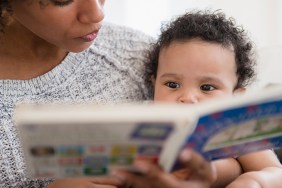Giving a child the gift of languages is one of the most precious gifts any parent can give, especially in our increasingly global world. Of course it’s not magic – if you only speak one language at home it’s going to be hard to pass two down to your child, but for multi-lingual households wanting to raise a bilingual child there are a number of strategies to consider to optimize success and stay on top of developmental milestones. To find out more we spoke with Craig Selinger, a speech-language pathologist and the owner of Brooklyn Letters.
Momtastic: What are the best strategies for raising a bilingual child?
Craig Selinger: There are several important factors to consider when exposing a baby/toddler/child to one or more languages. These variables are between the child and the adult(s): how many words they hear by a live adult and the number of high-quality interactions/opportunities for turn-taking. Turn-taking means the baby/toddler/child communicates, e.g., smiles, points, produces a sound/word, and the adult reciprocates by acknowledging the child’s intent. Turn-taking can also be adult-driven, and of course, this should occur naturally during play. Toddlers between 18-24 months of age who are engaged in more language-rich turn-taking, average 14 to 27 percent higher scores on their IQ tests when these children were tested later at 9-14 years of age. If you want to improve your child’s IQ score, the most important factors are the quantitative and qualitative interactions the child experiences from birth to 36 months of age. Recently, however, researchers are cautioning the interpretation of this data.
Here are the best strategies for boosting a little one’s vocabulary and IQ (regardless of how many languages they are exposed to):
-
- Turn off electronic devices
- Getting your child’s attention with language-rich age-appropriate activities e.g. arts and crafts, music, pretend play, puzzles, physical play, books, sensory activities, etc.
- Take advantage of what your child is interested in and focused on it
- Talk about what you and your child are experiencing.
- Build background knowledge by having your child exposed to varied experiences, e.g., taking the bus, gardening, hiking, going to the library, shopping at the grocery store, etc.
- Allow your child to be curious and follow their lead
- Explicitly teach vocabulary by building a language-rich environment.
- Tell stories
- Read books (in different languages when teaching more than one language)
Momtastic: What are the biggest mistakes parents make when trying to raise a bilingual child?
Craig Selinger: Parents’ biggest mistakes when raising a bilingual child are not exposing the child to a second language right away, particularly when one caregiver speaks more than one language. Further, teaching a secondary or tertiary language must be words spoken from an adult and not from a device.
Also, parents think that speaking in more than one language will confuse their little ones. This is not true. Babies are hardwired from day 1 to decipher speech sounds from noise and to discriminate sounds in all languages. The earlier you expose babies to spoken words by live adults, babies’ brains will identify and recognize these sounds. As little ones age, their brains are less plastic and it will become more challenging for them to process these distinct sounds in words. Their brains are statistical, complex machines and their minds will parse out multiple languages when spoken to. As the baby/child is exposed to a new language, it’s use it or lose it. So if a parent invests time and energy into exposing their little one to a second language, they must continue to stimulate their child with dual or more languages.

Momtastic: Is there a difference between boys and girls when it comes to how easy a child picks up the language?
Craig Selinger: Some research demonstrates that girls tend to be a bit more advanced at learning languages than boys. Boys are at a higher risk of having developmental speech-language and learning delays than girls. This is because boys have a higher genetic disposition and increased risks due to in utero factors than girls, so boys overall have more difficulties acquiring language than girls. For example, there’s a significantly higher rate of autism in boys than girls. Regardless, it’s important that all children hit their communicative milestones no matter how many languages they are exposed to.
Momtastic: Any tips for parents trying to raise a bilingual child but one of the parents doesn’t speak both languages?
Craig Selinger: One of the most popular bilingual philosophies for rearing multilingual children is one-parent-one-language. In real life, it’s hard to follow it. However, what’s even more important is parents speak the languages they want to talk to their children. It comes down to what each family is most comfortable with and what their goals are. For example, do they want their child to be dominant in one language (speaking, understanding, reading, writing)? Or do they want their child to be competent in listening, but not speaking, reading and writing in the second language? Once the caregiver(s) figure out what their expectations are for their children (speaking, listening, reading, writing), the parent(s) need to consider how they expose their child to these languages (verbal and written forms).
Momtastic: Is it important that a child goes to a bilingual school if there are two languages spoken at home?
Craig Selinger: Again this comes down to what the goals are for their child. If they want their multilingual child to be competent in reading and writing, sending their child to a bilingual school makes sense, assuming the school teaches bilingual literacy.
Momtastic: What are some signs that a child is having trouble mastering both languages?
Craig Selinger: Multilingual children will acquire each language at a slower rate compared to their monolingual peers. It’s important to recognize what the child’s dominant language is for speaking and understanding. The multilingual child’s overall language development will be equal to that of the monolingual child. For example, the average child at 24 months speaks 200-300 words. A red flag is if a child isn’t talking a total (regardless of the number of languages) of 50 words and isn’t combining words, the child should be evaluated by a speech-language pathologist. If it’s a bilingual child speaking Creole and English, when you combine the number of words they say, e.g. child produces 40 words in English and 15 in Creole, it should total at least 50 words. This child should also be combining any two-word combination.
Another example is a 3 ½ year old speaking in 2-3 word utterances (dominant language) while his or her monolingual peers are readily speaking in complete sentences, including compound sentences and even complex ones. This is a significant difference compared to their peers. I would recommend that a speech-language pathologist evaluate this 3 ½ year old. This is typically a red flag if their dominant language is significantly (very noticeable) behind their monolingual peers.








